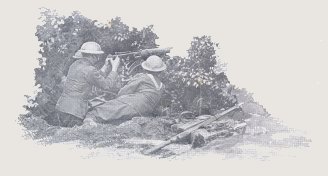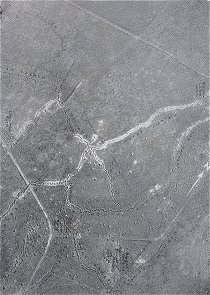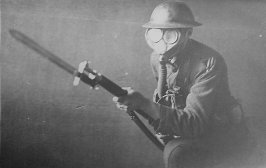
Fifty-ninth Brigade
The Fifty-ninth Infantry Brigade of the Thirtieth Division, organized at Camp Sevier, S. C., in September, 1917, was composed of the 117th and 118th Infantry regiments and the 114th Machine Gun Battalion. The 117th Infantry originally was the Third Tennessee Infantry, the 118th Infantry was the former First South Carolina Infantry, while the machine gun battalion was made up of Troops A, B, C, Tennessee cavalry, from Nashville, Chattanooga and Athens, respectively. To bring them up to war strength in accordance with the revised tables of organization, there were large infusions of draft men into each unit of the brigade in the fall of 1917. These men were largely from Tennessee and the Middle West. They made most excellent soldiers.
The first commander of the brigade was Gen. W. S. Scott. He was succeeded soon after its organization by Gen. Lawrence D. Tyson, of Knoxville, who went to Camp Sevier as the head of all the Tennessee national guard troops. Gen. Tyson commanded the brigade through its period of training at Camp Sevier, in all of its operations overseas, and until it was mustered out of service in April, 1919. Though most brigades went through a series of changes in the personnel of their higher commanders during the war, the Fifty-ninth was peculiarly an exception in this respect. Gen. Tyson remained with it during its entire Sorvice. So also did Lieut.-Col. Thomas J. Wyrick, brigade adjutant, and Lieuts. Rye and Milburn, Gen. Tyson's aides. Colonel Spence commanded the 117th Infantry from its organization until its discharge, but Col. Peter K. McCulley was succeeded by Col. Orrin R. Wolfe in France as commander of the 118th Infantry. Major J. Perry Fyfe, who was the first commander of the machine gun battalion, was relieved by Major E. B. Cantey after the brigade's arrival overseas.
Movement of the brigade from Camp Sevier, where it trained for approximately eight months after its organization, began early in May, 1918. The route taken was by New York to Liverpool, across England, and then by the English Channel to Calais, France. Before the end of the month all units of the brigade were in France and under the intensive training of English instructors. On July 4 the brigade moved forward into Belgium, the first American troops to enter the little country. The division remained in support of the 33rd and 49th British Divisions for several days, but units up to the battalion went into the battle line for real experience. The Thirtieth Division finally took over the Canal Sector from the 33rd British on August 17, and the brigade thereafter saw front line duty daily until its withdrawal.
 During
the period in Belgium, which was largely spent in accustoming the regiments
to trench warfare and in training them for the big offensive a month later
in the Somme area, the casualties of the brigade were very light. They
included two officers killed, four officers wounded, four enlisted men
killed, five died of wounds, and fifty-six wounded, a total of 71 for
the operations in Belgium.
During
the period in Belgium, which was largely spent in accustoming the regiments
to trench warfare and in training them for the big offensive a month later
in the Somme area, the casualties of the brigade were very light. They
included two officers killed, four officers wounded, four enlisted men
killed, five died of wounds, and fifty-six wounded, a total of 71 for
the operations in Belgium.
The brigade was withdrawn from the Canal Sector September 4-5 and placed in reserve for a short course in training with tanks. Two weeks later the final move in preparation for the big offensive between St. Quentin and Cambrai was made, and on September 23 the brigade took over the line just west of Bellicourt from the First Australian Division. The 118th Infantry went into the front lines, with the 117th Infantry in support. They were relieved shortly before the attack by the 60th Brigade.
 The
plan of battle was that the Sixtieth Brigade, plus Company H, of the 117th
Infantry, and the 114th Machine Gun Battalion, should attack on the divisional
front, penetrate the barbed wire entanglements, and capture Bellicourt
and Nauroy. Its elements were to have the protection of a creeping
barrage and be preceded by a strong array of tanks. The Fifty-ninth
Brigade, was allotted the task of creating a divisional reserve and exploiting
the line to the southeast after the St. Quentin Canal had been crossed.
Exploitation of this territory was assigned to the 117th, while
the 118th made up the divisional reserve. [Photo at right
is "near Bellicourt."]
The
plan of battle was that the Sixtieth Brigade, plus Company H, of the 117th
Infantry, and the 114th Machine Gun Battalion, should attack on the divisional
front, penetrate the barbed wire entanglements, and capture Bellicourt
and Nauroy. Its elements were to have the protection of a creeping
barrage and be preceded by a strong array of tanks. The Fifty-ninth
Brigade, was allotted the task of creating a divisional reserve and exploiting
the line to the southeast after the St. Quentin Canal had been crossed.
Exploitation of this territory was assigned to the 117th, while
the 118th made up the divisional reserve. [Photo at right
is "near Bellicourt."]
The sector of attack for the division was considered the most strongly fortified part of the whole Hindenburg Line, which extended from the English Channel to the Swiss border. The defensive fortifications were thought to be the strongest that could possibly be erected and capable of withstanding any offense. In addition to the St. Quentin Canal, which reached a depth of 75 feet at places and some 150 feet in width, the Germans had built four series of trenches, each of which was protected by heavy barbed wire entanglements. It was through these obstacles that the assaulting waves had to pass. At the apex of the defenses of the German lines, and in front of Bellicourt, the canal ran through a tunnel, in which 30,000 troops could be billeted in safety. The approaches to the tunnel were made almost impregnable by numbers of machine guns, which commanded the canal both north and south. Furthermore, smaller tunnels made connection with many points of the trench system in front of the canal.
Two elements favored the attack. The first of these was an intense artillery preparation from hundreds of British and Australian guns. These played upon the enemy lines, but did little damage to the barbed wire. The other element was a heavy fog, which concealed the advance of the Americans and prevented the full effect of the German machine gun and rifle fire from playing upon them accurately. Undoubtedly, many of the companies became lost from each other and wandered from the direction of their objectives, but their losses were not so heavy as they would have been if the morning had been clear.
The crushing of the main defenses of the line and the cleaning up of machine gun nests continued throughout September 29 and the two succeeding days, when the brigade and division were relieved for a short time to rest and recuperate for further attacks. The brigade's casualties in the drive upon the Hindenburg Line, which stands out as one of the great battles of the war, were 854 out of a total strength of 7,661 men and officers. They were divided as follows: officers killed, 3; officers wounded, 37; men killed, 79; men died of wounds, 39; men wounded, 696.
 The
heaviest and bloodiest fighting of the brigade, however, was upon October
8 and 9. In these two days the towns of Geneve, Ponchaux, Montbrehain,
Brancourt, Premont, Busigny, and Becquigny were captured, and an advance
of close to 10,000 yards was made against the most determined resistance
by the German divisions with machine guns, artillery, and infantry. The
attack was taken up on October 10 and 11 by the Sixtieth Brigade. On
October 12 the Thirtieth Division was relieved by the Twenty-seventh American
Division for a brief rest. However, the Thirtieth was called back
on October 16, and the following morning the Fifty-ninth Brigade again
took up the battle against the enemy. It captured Molain and advanced
across the Selle River before it was relieved by the Sixtieth Brigade,
which continued the fighting until the afternoon of October 19.
The
heaviest and bloodiest fighting of the brigade, however, was upon October
8 and 9. In these two days the towns of Geneve, Ponchaux, Montbrehain,
Brancourt, Premont, Busigny, and Becquigny were captured, and an advance
of close to 10,000 yards was made against the most determined resistance
by the German divisions with machine guns, artillery, and infantry. The
attack was taken up on October 10 and 11 by the Sixtieth Brigade. On
October 12 the Thirtieth Division was relieved by the Twenty-seventh American
Division for a brief rest. However, the Thirtieth was called back
on October 16, and the following morning the Fifty-ninth Brigade again
took up the battle against the enemy. It captured Molain and advanced
across the Selle River before it was relieved by the Sixtieth Brigade,
which continued the fighting until the afternoon of October 19.
From October 5 to 19, inclusive, covering this hard fighting beyond the Hindenburg Line, the brigade suffered 2,571 casualties. Of 194 officers, 22 were killed, 1 died of wounds, and 66 were wounded. From the enlisted personnel of the brigade, comprising 6,857 men, 382 were killed, 56 died of wounds, and 2,044 were wounded. Summarizing the casualties of the brigade from the time it went into the line until it was finally withdrawn, the total killed and wounded of officers and enlisted men was 3,496, or 45.5 per cent of the brigade's strength. The units of the brigade advanced approximately 19,700 yards for a penetration of about 11 miles into the lines of the enemy.
While exact figures are impossible because of the rapidity of the advance and the fierceness of the fighting, yet a fairly accurate count of the spoils taken by the brigade in its operations in the line shows the following: prisoners captured, 2736; field pieces taken, 65; machine guns captured, 446; rifles and other small arms, 4171; trench mortars, 72; anti-tank guns, 25; bicycles, 200; anti-aircraft guns, 5; minnenwerfers, 3; and square miles of territory taken, 18.2. In the attack on the Hindenburg Line and the operations that followed it, the following advances were made: jumping-off line to St. Quentin Canal, 1,900 yards; St. Quentin Canal to objective on September 29, 2,400 yards; operations of October 7, 8, and 9, 9,800 yards; operations of October 17 and 18, 5,600 yards.
Exhausted by the long siege of fighting, the brigade was withdrawn with the rest of the division to the Heilly training area near Amiens on October 20. Replacements for the thinned ranks were to be drawn and men and officers were to be given a few days of rest before returning to the fighting again. Just when orders were expected for a return to the front, the armistice was signed and all fighting ceased. Toward the end of November orders were received from American General Headquarters to entrain for the Le Mans area. There the brigade remained until early in March, 1919, when it again entrained for St. Nazaire, where boats were waiting to transport its units to the United States. Landing was made at Charleston, South Carolina, during the last days of that month. The 118th Infantry was mustered out at Camp Jackson, but the 117th Infantry and the 114th Machine Gun Battalion, after great parades through Knoxville, Nashville and Chattanooga, were demobilized at Fort Oglethorpe, Georgia, about the middle of April, 1919.
Recognition of the splendid fighting qualities of the brigade is shown in the number of medals, crosses and citations bestowed upon it. General Tyson was awarded the Distinguished Service Medal by General Pershing for his sterling leadership during the battle activities of the brigade. One officer and seven men received the Congressional Medal, the highest and most coveted military honor that our government bestows. No other brigade in the history of the army has been awarded so many. Fifteen officers were decorated with the Distinguished Service Cross, while the same award was made to 69 enlisted men of the Brigade. British Military Crosses were bestowed upon 21 officers, and the British Military Medal conferred upon 54 men of the enlisted personnel. The Distinguished Conduct Medal was granted to 31 men. Citations for personal bravery were given to 57 officers and 250 men by Major-General Lewis, the division commander.
The brigade upon its return was a far different organization from what it was when its members left their homes nearly two years before. They came back battle-scarred veterans, bronzed and hardened from twenty months of service in the open under sun and rain, enduring the hardships of heat and cold. They served their apprenticeship in the school of war at Camp Sevier, where they hewed their camp and drill grounds out of pine forests and learned the rudiments of warfare from American and British instructors. They became masters of the art in the three months in which they were thrown against the best troops of the hitherto victorious German armies. They were at home equally in trench or in open warfare, able to cope with any foe they met, recognized as the peer of any troops on either side, and regarded as the superior of most of them.
[ Return to Knox County Genealogy Military Page ]
[ Return to Knox County Genealogy Main Page ]
Except as noted, all HTML code and graphics in the URL path [http://www.knoxcotn.org/military/wwi/] were created by and copyrighted 2001-2003 to Billie R. McNamara. All rights reserved. Please direct all questions and comments to Ms. McNamara.This page was last updated January 2, 2004. Visitor